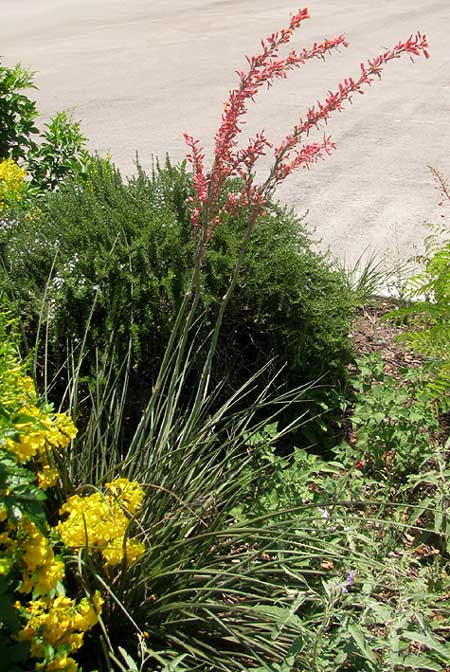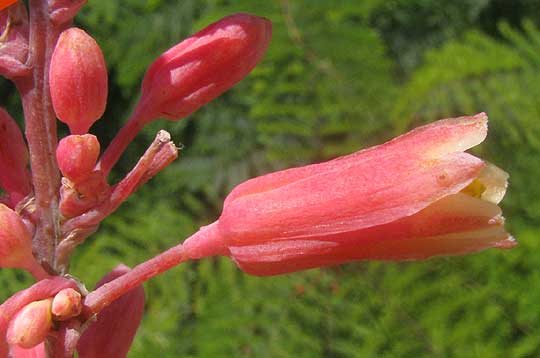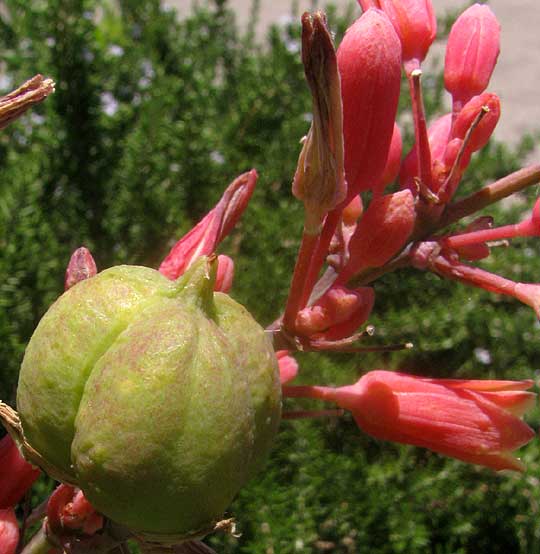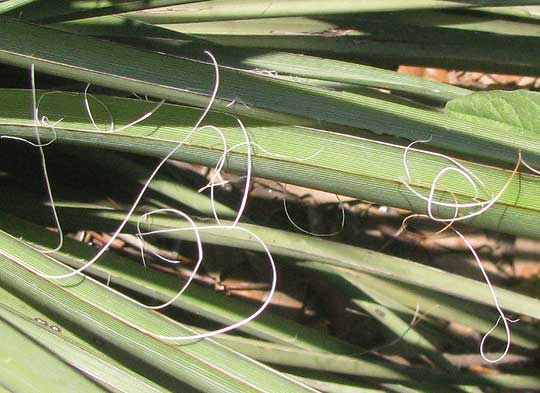Excerpts from Jim Conrad's
Naturalist Newsletter
from the June 8, 2014 Newsletter issued from the Frio Canyon Nature Education Center in the valley of the Dry Frio River in northern Uvalde County, southwestern Texas, on the southern border of the Edwards Plateau; elevation ~1750m (~5750 ft); N29.62°, W99.86°; USA
RED YUCCA
Last month we admired the red-flowered Soap Aloe abundantly planted around houses and along streets in Uvalde, still profiled at http://www.backyardnature.net/n/h/soapaloe.htm.
Now just as commonly planted another agave-type plant with waist-high clusters of red flowers on leafless stalks is putting on a similar show. Below, you can see such a plant beside the parking lot of Uvalde's fine public library:

At first glance the flowers are very similar to those of our earlier Soap Aloe, as shown below:

A longitudinal section showing how the stamens are affixed by their filaments to the bottom of the red perianth tube is seen below:

An egg-shaped, capsular fruit that eventually will split along its sutures to release numerous dark seeds is shown below.

These features are so similar to those of our previous Aloe that one of the fathers of American botany, Asa Gray, thought the species was indeed an Aloe, and named it Aloe yuccaefolia, a name meaning "Aloe with yucca-like leaves."
But, those yucca-like leaves are so different from those of succulent aloes that maybe Gray should have been more careful. The blades not only are hard like yucca leaves but also many pale, hairlike filaments conspicuously curl away from the blade margins, exactly as in many yucca species, as shown below:

So, who is this plant whose leaves look like those of yuccas, but whose flowers aren't at all like yucca flowers? You might want to review the flower of one of our local Spanish-Dagger yuccas here, Yucca treculeana, at http://www.backyardnature.net/n/14/140330yv.jpg.
Our Uvalde plant with red flowers like an aloe but hard, stiff leaves like a yuca, is neither a yucca nor an aloe, but rather HESPERALOE PARVIFLORA. Sometimes the five Hesperaloe species are known as false yuccas, but really there's no decent English name for them. The most commonly used English names for Hesperaloe parviflora are Red Yucca and Hummingbird Yucca, which is a shame because they're a long way from being yuccas.
Whatever common name we apply to the species, in the hot, arid, southwestern US states this plant has become very popular in xeriscape gardening and landscape design not only because of its prettiness but also for its drought tolerance, heat resistance, and low maintenance needs. Often xeroscapers regard it as a spineless alternative to Agave and Yucca horticultural species.
The species evolved these admirable qualities as it adapted to life in its native distribution area, which was mainly arid northern Mexico and contiguous southern and western Texas. Its exact native distribution is uncertain, however, because for such a long time it's been propagated by people outside its native haunts, just because it's so pretty.